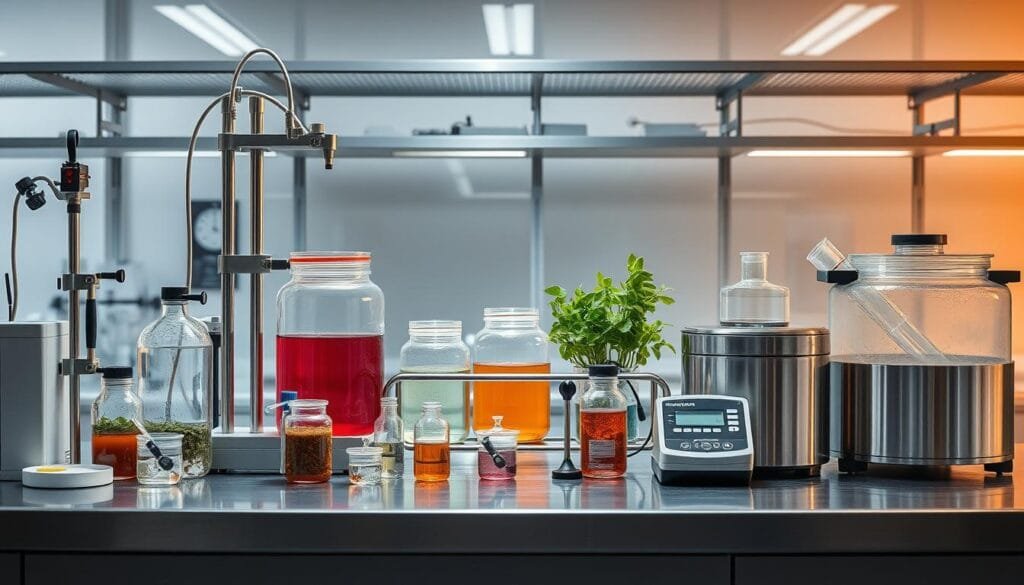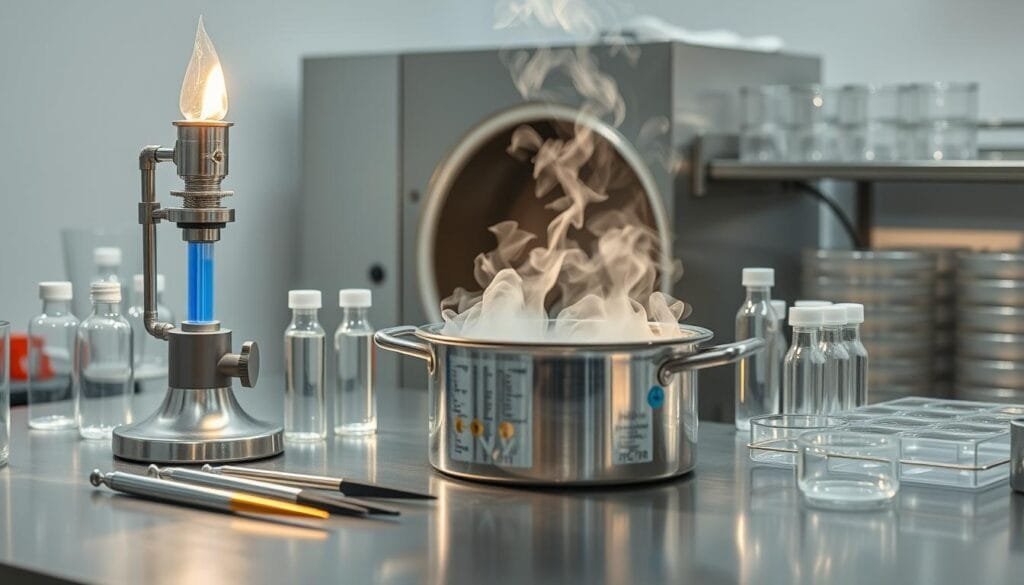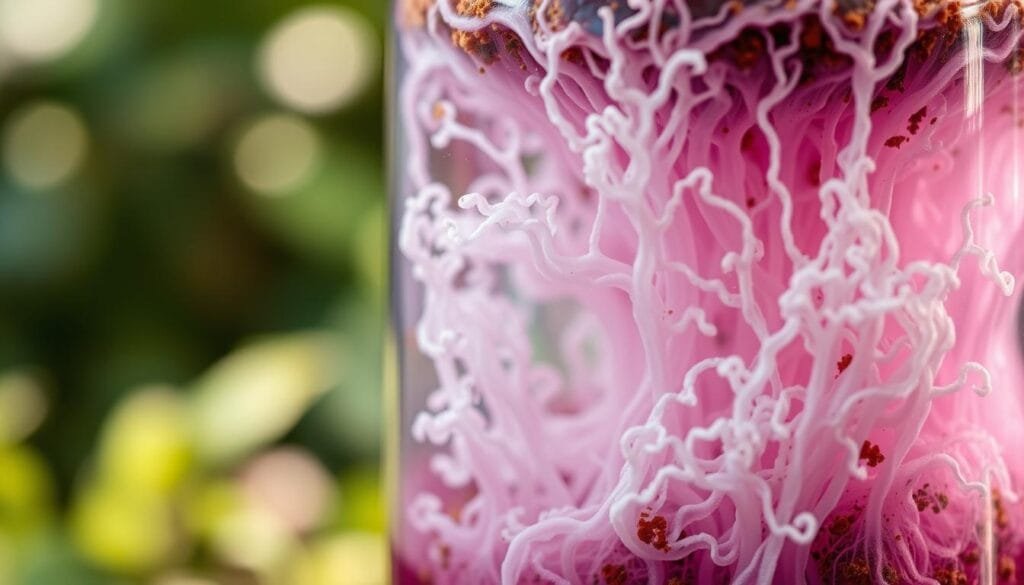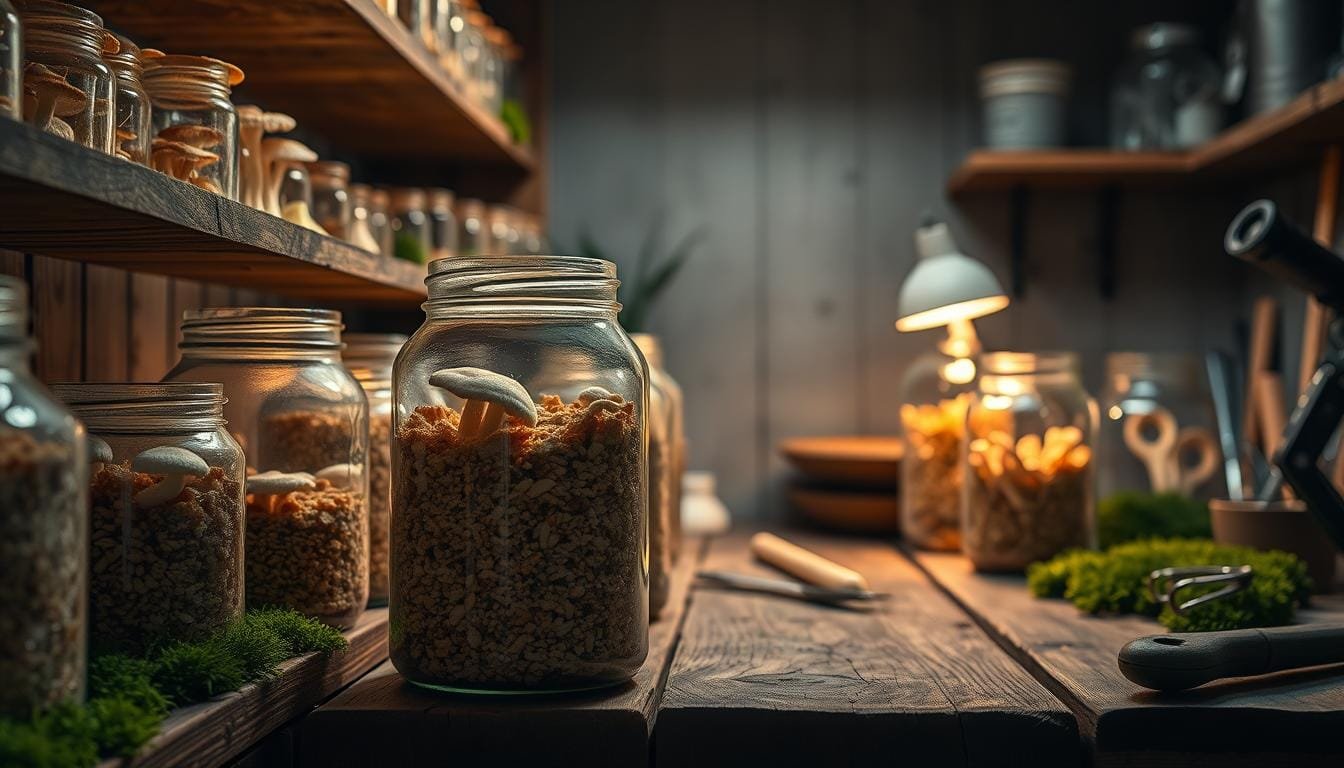Ever wondered how to speed up mushroom growing and get better results? The answer is using liquid culture methods. In this guide, we’ll show how liquid culture can change your DIY mushroom growing. It makes growing mushrooms at home easier, quicker, and more reliable.
Liquid culture is like a fertile garden for mycelium, which is the vegetative part of fungi. It’s different from traditional spore starting because it’s quicker and gives more consistent results. Imagine making your grain spawn and saving money compared to buying it! Now, let’s explore the basics of liquid culture. This guide is perfect for enthusiasts and home growers wanting to grow mushrooms, including gourmet types like oyster and lion’s mane.
Key Takeaways
- Liquid culture speeds up colonization and gives more predictable results than spore starting.
- Using liquid culture to create grain spawn can cut down costs.
- The best sugar-to-water ratio for nutrient solutions changes with different ingredients like light malt extract and honey.
- Using sterile techniques boosts success, with sterilization recommended at 15 PSI for 20 minutes.
- Shaking daily and keeping incubation temperatures between 70-80°F are key for healthy mycelium growth.
Introduction to Liquid Culture
For those new to mushroom growing, learning about liquid culture can really help. This introduction to liquid culture will teach you the basics and show its benefits. It’s better than old methods.
What is Liquid Culture?
Liquid culture is a nutrient-rich solution that helps mushroom mycelium grow fast. It’s a great alternative to old spore tricks. Adding mushroom spores to this solution can make colonizing faster and lower contamination risks. For light malt extract, mix 1 gram with 600 milliliters of water for a 0.17% solution. Honey needs 24 grams per 600 milliliters, making a 4% solution.
Benefits of Using Liquid Culture for Mushroom Cultivation
Using liquid culture to grow mushrooms has several key benefits:
- Faster Colonization: It cuts down inoculation time to 10 days to 3 weeks, much faster than old ways.
- Reduced Costs: It can make creating grain spawn 75% cheaper than buying spawn.
- Consistency and Efficiency: Liquid culture helps mycelium grow evenly and makes storing it easy. This ensures steady mushroom growth.
- Lower Contamination Risk: With no need for complex lab gear, it’s easier for beginners and lessens contamination chances.
Mycelium grows best when it’s between 21-26 degrees Celsius (70-80 Fahrenheit). Also, sterilizing grain at 15 PSI for 150 minutes helps avoid contaminants.
Knowing these liquid culture basics can lead to better mushroom yields. Try applying these tips to boost your growing success.
Necessary Materials and Equipment for Liquid Culture
To start and keep a liquid culture doing well, you need the right tools and materials. Knowing which equipment and materials work best for mushroom culture makes a big difference. Here are the must-haves and some extras that could help you grow mushrooms better.
Essential Supplies
- Mason Jars with Airtight Lids: These are the main containers for your liquid culture. It’s important they’re sterile to prevent contamination.
- Pressure Cookers: Essential for sterilization, they should reach at least 15 PSI to kill off almost all contaminants. This is crucial for keeping your culture safe.
- Digital Scales: They ensure you measure sugar sources like light malt extract, dextrose, or honey accurately. Proper nutrient solutions are usually about a 4% sugar concentration.
- Various Sugar Sources: You’ll use sugars like light malt extract, dextrose, and honey. For example, you might need 20 grams of light malt extract per liter of water.
- Sterilized Water: This is for mixing your nutrient solution. Distilled water is best because it’s pure.
Optional Tools and Enhancements
These optional tools can improve your mushroom growing process and lead to stronger mycelium growth.
- Magnetic Stirrers: They help spread the mycelium evenly in the liquid culture. Stirring often stops clumps and supports growth.
- Brewers’ Yeast: This adds extra nutrients to your culture, helping mycelium grow faster and healthier.
- Incubation Chambers: It’s key to keep a steady temperature between 20-25°C (68-77°F) in the dark. This helps mycelium grow well.
Using these mushroom cultivation supplies can increase productivity and help colonization succeed. With these tools and materials ready, you can manage and improve your liquid culture work.

Step-by-Step Guide: How to Perform a Liquid Culture
Learning to make liquid culture is key to growing mushrooms well. This guide shows every step, from making the nutrient mix to keeping the culture moving. Follow each step carefully to grow mycelium well.
Preparing the Nutrient Solution
Start by making a nutrient-rich broth for the culture. You can use:
- Light Malt Extract: Mix 1 gram with 600 milliliters of distilled water.
- Honey: Mix 24 grams (4 percent) with 600 milliliters of distilled water.
These options give mycelium the nutrients it needs to grow. Mix until the nutrients dissolve completely.
Sterilizing the Liquid Culture
Getting rid of contaminants is crucial. Put the nutrient mix into a container that can be sterilized, like a jar with a metal top. The lid should have an airlock or a hole with sterile tape over it. Sterilize at 15 PSI for 20 minutes for a clean environment.

Inoculating the Solution
It’s important to add the culture correctly to avoid contamination. With a clean syringe, take 1-2 milliliters of culture for a quart-sized jar or 5-10 milliliters for a 5 lb bag of grain. Clean all surfaces and tools with 70% alcohol. Then, add the culture to the sterilized solution or grain. Cover the inoculation spots with sterile tape.
Incubation and Agitation
Keep the inoculated mix at 21-26 degrees Celsius (70-80 degrees Fahrenheit) to grow mycelium evenly. Shake the liquid culture every day to spread nutrients and air. Gently swirling the jar works well. Mycelium should fully grow in 14-45 days.
| Step | Details | Note |
|---|---|---|
| Preparing Nutrient Solution | Light Malt Extract: 1 gram per 600 ml water; Honey: 24 grams per 600 ml water | Stir well |
| Sterilizing the Liquid Culture | 15 PSI for 20 minutes | Use sterile containers |
| Inoculating the Solution | 1-2 ml for jars; 5-10 ml for 5 lb bags | Use sterile techniques |
| Incubation and Agitation | 21-26°C (70-80°F); Agitate daily | 14-45 days for full colonization |
Tips for Successful Liquid Culture Maintenance
Maintaining liquid culture needs a lot of attention to detail. This is to nurture healthy mycelium. Following key liquid culture tips is essential for a thriving environment.

First, storing cultures in a fridge helps keep them potent. This also cuts down the chance of contamination. Use airtight containers to keep out harmful microbes. Shaking the cultures regularly helps mycelium grow evenly and stops clumping.
Keeping an eye on your liquid culture is vital. Look out for signs of contamination, like too much cloudiness, color changes, or bad smells. A healthy liquid culture is clear with mycelium blobs visible. Taking quick action can save a culture from being completely lost.
Handling common issues is part of maintaining liquid culture. For instance:
- Slow Growth: Keep an ideal temperature range of 70-80 degrees Fahrenheit.
- Clump Formation: Shake the culture often to spread out the mycelium.
- Contamination: Quickly isolate and get rid of any contaminated cultures to avoid spread.
Using the right recipes and protocols matters too. For example, you start with 1 liter of distilled water and 40 grams of light malt extract for liquid culture broth. This mix creates a nutrient-rich environment for mycelium. Adding 1 gram of brewer’s yeast is an option for extra nutrients.
The table below shows key points for effective liquid culture tips:
| Procedure | Details |
|---|---|
| Liquid Culture Broth Preparation | 1 liter (1000 ml) distilled water, 40 grams light malt extract, 1 gram brewer’s yeast (optional) |
| Pressure and Sterilization | 15 psi for 30 minutes |
| Optimal Sugar-to-Water Ratio | 1 gram of malt extract per 600 ml water, 24 grams of honey per 600 ml water (4% concentration) |
| Inoculation Volume | 1-2 ml for a quart-sized jar, 5-10 ml for a 5 lb bag of sterilized grain |
| Incubation Temperature | 21-26°C (70-80°F) |
In conclusion, proper storage, regular checks, and applying best practices are key. This ensures the growth of healthy mycelium and avoids common issues in liquid culture maintenance.
Conclusion
We’ve explored the world of liquid culture in this guide, highlighting its benefits for growing mushrooms. Liquid culture speeds up colonization and increases the success rate compared to spore inoculation. This makes growing mushrooms at home more predictable and successful.
Growers are now equipped with everything they need to start or improve their mushroom projects. We’ve shared a step-by-step guide, details on what materials to use, and how to maintain them. Following these steps ensures better control over the growing process and leads to healthier mycelium.
Liquid culture methods can make gardening more efficient and rewarding. By using liquid culture syringes, keeping the right temperature, and sterilizing everything carefully, anyone can grow mushrooms successfully. This opens the door to a fruitful mushroom cultivation journey.
FAQ
What is Liquid Culture?
Liquid culture is a home mushroom growing technique. It uses a sterile, nutrient-packed liquid for mushroom mycelium growth. This approach speeds up the mycelium’s growth and results in quicker and more uniform mushroom production.
What are the benefits of using liquid culture for mushroom cultivation?
Liquid culture comes with many benefits. It offers fast colonization times and lowers the risk of contamination. It also removes the need for complex lab gear.
It’s great for storing and expanding mycelium. This makes it a top choice for both beginners and pros looking to get more consistent yields.
What essential supplies are needed to create a liquid culture?
To start a liquid culture, you’ll need mason jars with tight lids and a pressure cooker for sterilizing. You’ll also need digital scales for accurate measurements and sugar sources like light malt extract, dextrose, or honey.
Are there any optional tools that can enhance the liquid culture process?
Yes, there are optional tools. A magnetic stirrer improves mycelium distribution and brewers’ yeast adds extra nutrients. These can help grow stronger mycelium.
How do I prepare the nutrient solution for liquid culture?
You prepare the nutrient solution by mixing distilled water with sugars. This creates a nutrient-rich broth. It’s key for feeding the mycelium as it grows.
What methods can I use for sterilizing my liquid culture?
You can sterilize your liquid culture with a pressure cooker. This ensures everything is free of contaminants. Keeping equipment and solutions clean is critical to avoid any growth issues.
How do I inoculate the solution?
To inoculate, you add mushroom spores or mycelium into the nutrient solution. This is done in a clean environment to keep contamination low.
What are the steps for proper incubation and agitation?
Incubation means keeping the culture at the right temperature for growth. Regular shaking is needed too. This helps with the even spread and development of mycelium.
How can I maintain a liquid culture successfully?
For successful maintenance, store cultures in a fridge and use airtight containers to avoid contamination. Give your cultures a shake often for balanced growth. Watch for contamination and take action immediately if needed.
